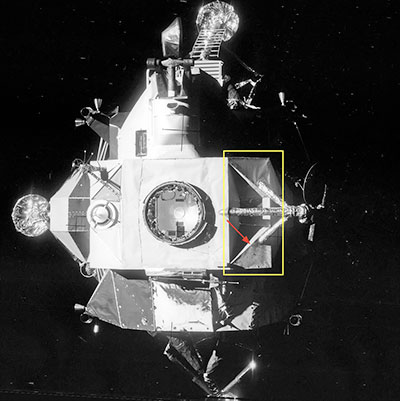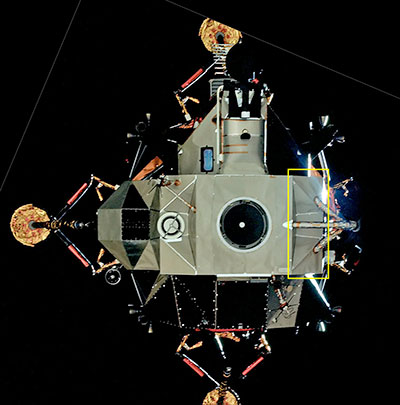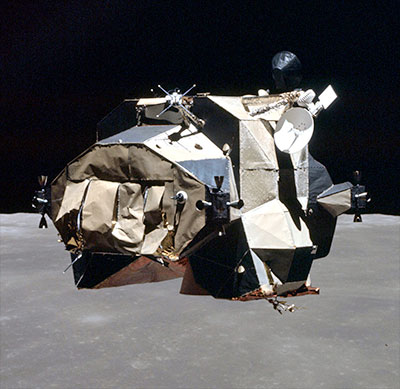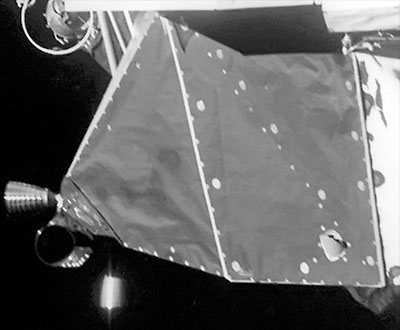|
Author
|
Topic: Apollo 13: Indications of damage
|
JohnPaul56
Member Posts: 191
From: Montclair, NJ, USA
Registered: Apr 2010
|
 posted 11-17-2018 07:47 AM
posted 11-17-2018 07:47 AM
  
After the explosion on Apollo 13, was there any visual indication that the lunar module upper stage was hit by any debris from the explosion in the service module?An additional question, wasn't there observed damage to the nozzle extension on the SM? Was there any speculation as to how the path of debris could have impacted the engine nozzle? |
LM-12
Member Posts: 3324
From: Ontario, Canada
Registered: Oct 2010
|
 posted 11-17-2018 08:43 AM
posted 11-17-2018 08:43 AM
  
There is a LM jettison photo mentioned and discussed on page 2 of this thread on 10-15-2012 that seems to show some debris on top of the LM ascent stage. |
Fra Mauro
Member Posts: 1624
From: Bethpage, N.Y.
Registered: Jul 2002
|
 posted 11-17-2018 11:50 AM
posted 11-17-2018 11:50 AM
   
I'm not sure that is debris on top of Aquarius. As for the SM nozzle being struck, debris could have bounced off the antenna, or it could have impacted debris as the stack swerved after the explosion. They came close to gimbal lock so there was significant movement. |
oly
Member Posts: 971
From: Perth, Western Australia
Registered: Apr 2015
|
 posted 11-17-2018 07:04 PM
posted 11-17-2018 07:04 PM
   
quote:
Originally posted by LM-12:
There is a LM jettison photo mentioned and discussed that seems to show some debris on top of the LM ascent stage.
I hope you reference this photo that appears to show a puncture to the dark thermal control blanket at the rear side of the LM, opposing the rendezvous window.I have always believed that the LM was shielded from explosive debris by the CM heat shield and the geometric cone formed by the layout of the structure. |
Fra Mauro
Member Posts: 1624
From: Bethpage, N.Y.
Registered: Jul 2002
|
 posted 11-17-2018 07:46 PM
posted 11-17-2018 07:46 PM
   
I agree that the LM was shielded from damage by the CSM. |
LM-12
Member Posts: 3324
From: Ontario, Canada
Registered: Oct 2010
|
 posted 11-17-2018 07:49 PM
posted 11-17-2018 07:49 PM
  
Yes 8564, same photo. |
LM-12
Member Posts: 3324
From: Ontario, Canada
Registered: Oct 2010
|
 posted 11-17-2018 08:29 PM
posted 11-17-2018 08:29 PM
  
quote:
Originally posted by oly:
I have always believed that the LM was shielded
Including the S-band antenna? |
oly
Member Posts: 971
From: Perth, Western Australia
Registered: Apr 2015
|
 posted 11-17-2018 10:27 PM
posted 11-17-2018 10:27 PM
   
The painting shown at the beginning of this NASA page helps to visualize how the CM heatshield could act as a debris shield. Depending on the orientation of the S-Band dish during the tank failure, it may have been extended outside of the shielded area, as is was mounted on an outrigger anyway.The areas of the thermal blankets that appear to show debris may only be blistering, as can be seen in other Apollo images. The view available to the crew of the LM and CM external surface was limited and confined to areas within the area of shielding, so identification of damage was only possible following the LM jettison, when the crew were tired and under a high workload of reentry prep. |
Andy Anderson
Member Posts: 87
From: Perth, Australia
Registered: Dec 2009
|
 posted 11-18-2018 01:29 AM
posted 11-18-2018 01:29 AM
   
quote:
Originally posted by JohnPaul56:
...was there any visual indication that the lunar module upper stage was hit by any debris from the explosion in the service module?
I know of no NASA documentation that discusses or investigated the impingement of the stack (including the lunar module) by objects from the explosion other than the expelled almost complete Bay 4 panel impacting one of the high gain reflector feeder horns — which may have been the "bang" the crew heard as a small atmosphere temporarily formed around the ship.After the explosion and the resultant spacecraft maneuvers, there was lot of material from Bay 4 that "accompanied" the spacecraft making optic alignments impossible but seemingly slowly dispersed as the mission continued with occasional sightings of larger bits. There is no mention by the crew about the condition of the LM when the punched of but they were a bit busy. However...
quote:
Originally posted by LM-12:
There is a LM jettison photo... that seems to show some debris on top of the LM ascent stage.
This is the photo (NASA AS13 59 8564) cropped and enhanced with the area highlighted. By way of comparison here is a nearly identical image of Apollo 14 (NASA A14 0948 74) - Antares departing for the lunar surface which shows no "contamination" of the same area.  I am curious why only that one triangular panel has deposits on it — my first thought was frozen propellant from the RCS but I really have no idea. As an aside concerning damage to the LM, here is an image of Apollo 16 Orion needing a bit of "panel" work after it's mission...  quote:
...wasn't there observed damage to the nozzle extension on the SM?[/B]
There was no readily identifiable damage to the nozzle but from the Investigation Panel 1 Anomaly Investigation report: A brown stain was observed on the outside surface of the service propulsion system engine nozzle extension, near the plus Z axis, and in line with the vent path from the vent annulus around the nozzle. |
oly
Member Posts: 971
From: Perth, Western Australia
Registered: Apr 2015
|
 posted 11-18-2018 04:26 AM
posted 11-18-2018 04:26 AM
   
quote:
Originally posted by Andy Anderson:
This is the photo (NASA AS13 59 8564) cropped and enhanced with the area highlighted.
Andy, thanks for this information, your first posted photo (NASA AS13 59 8564) shows some damage to the dark thermal blanket, second from left on the lower side, in the lower right area.Your third posted image of Apollo 16 "Orion" shows blistering of the thermal blankets below the S-Band antenna. I think this is what is evident in the area you highlighted. |
Andy Anderson
Member Posts: 87
From: Perth, Australia
Registered: Dec 2009
|
 posted 11-18-2018 04:43 AM
posted 11-18-2018 04:43 AM
   
Is this the area you are referring to Pete? |
oly
Member Posts: 971
From: Perth, Western Australia
Registered: Apr 2015
|
 posted 11-18-2018 05:12 AM
posted 11-18-2018 05:12 AM
   
Yes, this area seems to show impact damage. |
LM-12
Member Posts: 3324
From: Ontario, Canada
Registered: Oct 2010
|
 posted 11-18-2018 06:08 AM
posted 11-18-2018 06:08 AM
  
I also see (to the right of the yellow box) a similar type of contamination on the LM dish antenna itself: around the edge and on the stem part.The Apollo 13 LM seen in transposition and docking photo AS13-60-8581 also looks "clean" like the Apollo 14 image posted. |
Space Cadet Carl
Member Posts: 225
From: Lake Orion, Michigan
Registered: Feb 2006
|
 posted 11-19-2018 07:16 AM
posted 11-19-2018 07:16 AM
   
The skin of the LM was extremely thin in spots. Dents and warping of the skin was a normal condition. Also, if you look at the Orion ascent stage photo, there's those blistering bumps all over it. So, I'm not convinced you're seeing anything out of the ordinary on any of those Aquarius photos. |
oly
Member Posts: 971
From: Perth, Western Australia
Registered: Apr 2015
|
 posted 11-19-2018 08:09 AM
posted 11-19-2018 08:09 AM
   
quote:
Originally posted by Space Cadet Carl:
I'm not convinced you're seeing anything out of the ordinary on any of those Aquarius photos.
What about the punctured hole with torn edges and a section folded inward on the rectangular panel in the above image posted by Andy? No other images of Lunar modules show similarity. |
LM-12
Member Posts: 3324
From: Ontario, Canada
Registered: Oct 2010
|
 posted 11-19-2018 08:28 AM
posted 11-19-2018 08:28 AM
  
I think what you see as a hole folded inward is actually the LM part also seen on that same panel in the transposition and docking photo.That still looks like debris on the Apollo 13 panel and antenna to me. Would there be blistering on the antenna? |
oly
Member Posts: 971
From: Perth, Western Australia
Registered: Apr 2015
|
 posted 11-19-2018 09:56 AM
posted 11-19-2018 09:56 AM
   
I found an Apollo 12 image on a commercial site that shows something in the same area as the Apollo 13 "hole," I will look into this further when time permits.I don't see blistering on the S-band dish, there seems to be to be some material that is reflecting light, which may be debris, blistering or, judging by the condition of the thermal blanket around the docking hatch, may be some Kapton adrift. The star trails don't help by adding more "spots" in the image. As Andy posted, damage to the LM does not seem to have been reported or recorded, however there was a lot of debris clouded around the spacecraft until the velocity change resulting from engine burns left the debris cloud behind. The S-band steerable antenna surface finish was Thermal paint, and heaters controlled the steerable-antenna temperature, it may have experienced blistering, this is an interesting point. The S-band antenna photos from the National Air and Space Museum look to show a fiberglass material finish.
Here is some additional info regarding the S-Band antenna. |
oly
Member Posts: 971
From: Perth, Western Australia
Registered: Apr 2015
|
 posted 11-19-2018 08:12 PM
posted 11-19-2018 08:12 PM
   
Some online image searches reveal that the Apollo 9 lunar module does not have any object located on the thermal blanket in the same location. I could not find a clear example of the Apollo 10 CM online.The Apollo 11 command module has an object installed in the same thermal blanket, seen here and here . This shape can be found in several locations on the Apollo 11 LM, and may be some kind of vent port to allow heat or fumes to be extracted while the LM was within the adapter on the pad. |
mooncollector
Member Posts: 104
From: Alabama, USA
Registered: Feb 2011
|
 posted 11-22-2018 12:10 PM
posted 11-22-2018 12:10 PM
   
That triangular "hole" is present in the transposition and docking photos of Aquarius, it was there before the accident. |















